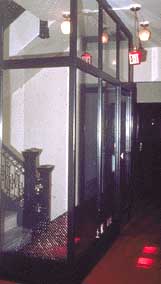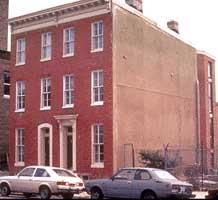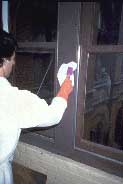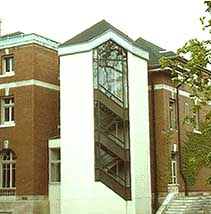
  

























 |

Enclosure that preserves decorative staircase and also meets safety code. |
In
undertaking rehabilitation work on historic buildings, it is necessary
to consider the impact that meeting current health and safety codes (public health, occupational health, life safety, fire safety, electrical,
structural and building codes) will have on character-defining spaces,
features, and finishes. Special coordination with the responsible
code officials at the state, county or municipal level may be required.
Securing required building permits and occupancy licenses is best
accomplished early in work project planning. It is often necessary to look beyond the "letter" of code requirements to their underlying purpose; most modern codes allow for alternative approaches and reasonable variance to achieve compliance.
Some historic building materials (insulation, lead paint, etc.) contain toxic substances that are potentially hazardous to building occupants. Following
careful investigation and analysis, some form of abatement may be
required. All
workers involved in the encapsulation, repair, or removal of known
toxic materials should be adequately trained and should wear proper
personal protective gear. Finally, preventive and routine maintenance
programs for historic structures known to contain such materials
should also be developed to include proper warnings and precautions.
Note: Although the work in this section is quite often an important aspect of rehabilitation projects, it is usually not part of the overall process of preserving character-defining features (identify, protect, repair, replace); rather, such work is assessed for its potential negative impact on the building's historic character. For this reason, particular care must be taken not to obscure, radically change, damage, or destroy character-defining features in the process of rehabilitation work to meet health and safety code requirements.
|
|
Considerations
|
....Health
& Safety
|
 |
Identify,
retain and preserve
|
recommended.....
|

|
| |

Small, compatible stairtower on rear elevation. |
Identifying
the historic building's character-defining spaces, features, and
finishes so that code-required work will not result in their damage
or loss.
Complying
with health and safety codes, including seismic code requirements,
in such a manner that character-defining spaces, features, and finishes
are preserved.
Removing
toxic building materials only after thorough testing has been conducted
and only after less invasive abatement methods have been shown to
be inadequate.
Providing
workers with appropriate personal protective equipment for hazards
found in the worksite.
Working
with local code officials to investigate systems, methods, or devices
of equivalent or superior effectiveness and safety to those prescribed
by code so that unnecessary alterations can be avoided.

Worker using poultice to remove lead paint safely. |
Upgrading
historic stairways and elevators to meet health and safety
codes in a manner that assures their preservation, i.e., so that
they are not damaged or obscured.
Installing
sensitively designed fire suppression systems, such as sprinkler
systems that result in retention of historic features and finishes.
Applying
fire-retardant coatings, such as intumescent paints, which expand
during fire to add thermal protection to steel.
Adding
a new stairway or elevator to meet health and safety codes in a
manner that preserves adjacent character-defining features and spaces.
Placing a code-required stairway or elevator that cannot be accommodated
within the historic building in a new exterior addition. Such an
addition should be on an inconspicuous elevation.
|
|
not
recommended.....
|

|
| |
Undertaking
code-required alterations to a building or site before identifying
those spaces, features, or finishes which are character-defining
and must therefore be preserved.
Altering,
damaging, or destroying character-defining spaces, features, and
finishes while making modifications to a building or site to comply
with safety codes.
Destroying
historic interior features and finishes without careful testing
and without considering less invasive abatement methods.

Large incompatible stairtower on highly visible elevation. Photo: Martha L. Werenfels, AIA. |
Removing
unhealthful building materials without regard to personal and environmental
safety.
Making
changes to historic buildings without first exploring equivalent
health and safety systems, methods, or devices that may be less
damaging to historic spaces, features, and finishes.
Damaging
or obscuring historic stairways and elevators or altering adjacent
spaces in the process of doing work to meet code requirements.
Covering
character-defining wood features with fire-resistant sheathing which
results in altering their visual appearance.
Using
fire-retardant coatings if they damage or obscure character-defining
features.
Radically
changing, damaging, or destroying character-defining spaces, features,
or finishes when adding a new code-required stairway or elevator.
Constructing
a new addition to accommodate code-required stairs and elevators
on character-defining elevations highly visible from the street;
or where it obscures, damages, or destroys character-defining features.
|
|

